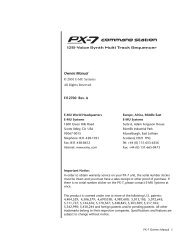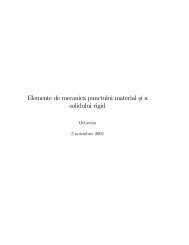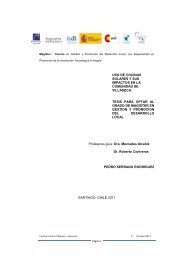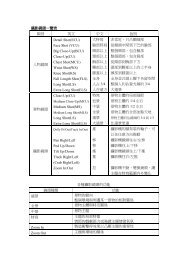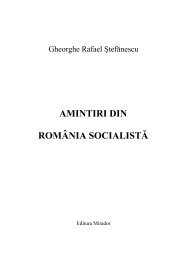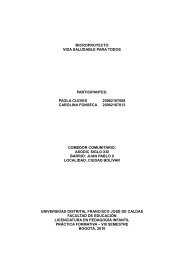Sources are specifically NOT Georgian so there is no ... - nocookie.net
Sources are specifically NOT Georgian so there is no ... - nocookie.net
Sources are specifically NOT Georgian so there is no ... - nocookie.net
You also want an ePaper? Increase the reach of your titles
YUMPU automatically turns print PDFs into web optimized ePapers that Google loves.
ABKHAZIA – HISTORICAL TIMELINE<br />
All <strong>so</strong>urces used <strong>are</strong> <strong>specifically</strong> <strong>NOT</strong> <strong>Georgian</strong> <strong>so</strong> <strong>there</strong> <strong>is</strong> <strong>no</strong> bias (even though <strong>there</strong> <strong>is</strong> an abundance of <strong>Georgian</strong> <strong>so</strong>urces from V century onwards)<br />
Period 2000BC – 100BC<br />
<br />
<br />
Today’s territory of Abkhazia <strong>is</strong> part of Western<br />
<strong>Georgian</strong> kingdom of Colch<strong>is</strong>, with capital Aee<br />
(Kuta<strong>is</strong>i - Kuta-Aee (Stone-Aee)). Territory<br />
populated by <strong>Georgian</strong> Chans (Laz-Mengrelians) and<br />
Svans.<br />
According to all h<strong>is</strong>torians of the time like Strabo<br />
(map on the left by F. Lasserre, French Strabo expert),<br />
Herodotus, and Pseudo-Skilak - Colch<strong>is</strong> of th<strong>is</strong> period<br />
<strong>is</strong> populated <strong>so</strong>lely by the Colkhs (<strong>Georgian</strong>s).<br />
The same <strong>Georgian</strong> culture ex<strong>is</strong>ted throughout<br />
Colch<strong>is</strong>. Th<strong>is</strong> <strong>is</strong> seen through archaeological findings<br />
in Abkhazia that <strong>are</strong> exactly the same as in the rest of<br />
western Georgia, with its capital in central <strong>Georgian</strong> city<br />
of Kuta<strong>is</strong>i. The fact that the centre of Colchian culture was<br />
Kuta<strong>is</strong>i <strong>is</strong> al<strong>so</strong> seen in the Legend of Ja<strong>so</strong>n and the<br />
Argonauts (Golden Fleece). They travel through town and<br />
river of Phas<strong>is</strong> (modern day Poti / Rioni, in Mengrelia), to<br />
the city of Aee (Kuta<strong>is</strong>i – in Imereti), where the king of<br />
Colch<strong>is</strong> reigns, to obtain the Golden Fleece (method of<br />
obtaining gold by <strong>Georgian</strong> Svans where fleece <strong>is</strong> placed<br />
in a stream and gold gets caught in it).<br />
<br />
Strabo in h<strong>is</strong> works Geography XI, II, 19 clearly shows that <strong>Georgian</strong> Svan tribes ruled the <strong>are</strong>a<br />
of modern day Abkhazia – “… in Dioscurias (Sukhumi)…<strong>are</strong> the Soanes, who <strong>are</strong> superior in<br />
power, - indeed, one might almost say that they <strong>are</strong> foremost in courage and power. At any rate,<br />
they <strong>are</strong> masters of the peoples around them, and hold possession of the heights of the Caucasus<br />
above Dioscurias (Sukhumi). They have a king and a council of three hundred men; and they<br />
assemble, according to report, an army of two hundred thousand; for the whole of the people <strong>are</strong><br />
a fighting force…” Al<strong>so</strong> we k<strong>no</strong>w of a <strong>Georgian</strong> Kudji dynasty that ruled Colch<strong>is</strong>, and in 3 BC<br />
voluntarily united with Eastern Georgia, under King Parnavaz.
Period 100BC – 300AD<br />
<br />
Colch<strong>is</strong> (inc. today’s territory<br />
of Abkhazia) becomes an<br />
auto<strong>no</strong>mous region of the<br />
Roman Empire (small periods<br />
under Parthians). Romans give<br />
a new name– Lazica, after<br />
<strong>Georgian</strong> Laz population of<br />
the <strong>are</strong>a.<br />
Period 300AD – 562AD<br />
<br />
<br />
<br />
Lazica (inc. today’s territory of Abkhazia) becomes partially independent. Name of the new<br />
Kingdom - Lazica-Egr<strong>is</strong>i (Laz-Megrelians), ruled by Laz Kings Gubaz, and later by Tsate. By<br />
the end of th<strong>is</strong> period Byzantium takes full control of the <strong>no</strong>rthern part of modern day Abkhazia.<br />
Byzantine h<strong>is</strong>torian Procopius of Caes<strong>are</strong>a states that towns of Sebastopol<strong>is</strong> (Sukhumi) and<br />
Pitiunt (Pitsunda/Bichvinta) <strong>are</strong> towns of Laz (<strong>Georgian</strong>), and Abazgs from time immemorial <strong>are</strong><br />
subjects of the Laz.<br />
Procopius of Caes<strong>are</strong>a further states that the stronghold of Tzebil (Tsebelda) <strong>is</strong> ruled by a <strong>no</strong>ble<br />
Laz, Terdet.<br />
Period 562AD – VII AD<br />
<br />
Lasica-Egr<strong>is</strong>i <strong>is</strong> ab<strong>so</strong>rbed by Byzantium, as an auto<strong>no</strong>mous region, keeping the old name. Later<br />
though it’s broken up into separate provinces, all subject to Byzantium.<br />
Period VII AD – VIII AD<br />
<br />
<br />
Arab invasions weaken Byzantium. Abazgia <strong>is</strong> mentioned as an er<strong>is</strong>tavat (principality).<br />
Capital of modern day Abkhazia, Sukhumi <strong>is</strong> first mentioned as Tskhumi (before Greek and<br />
Roman names were used - Sebastopol<strong>is</strong> and Dioscurias). Name derives from Svan word meaning<br />
hornbeam (many Sva<strong>net</strong>ian villages have the same root Tskhumar, Tskhomi, Tskhvim etc).<br />
Abkhazians call Sukhumi, Akua, a name first mentioned only in 18 th century.<br />
Period IX AD – X AD<br />
<br />
Egr<strong>is</strong>i/Lasica becomes fully independent under the name Kingdom of Abkhazia. King Leon II<br />
unifies western Georgia in its old borders and capital in Kuta<strong>is</strong>i.
Succes<strong>so</strong>r of the Egr<strong>is</strong>i Kingdom, Kingdom of Abkhazia derives its name from the principality<br />
of Abkhazia, whose er<strong>is</strong>tav (prince) Leon II previously ruled within the kingdom of Lasica/Egr<strong>is</strong>i,<br />
before becoming king of the whole western Georgia.<br />
- National language <strong>is</strong> <strong>Georgian</strong>. Th<strong>is</strong> <strong>is</strong> seen from<br />
everything that remained from that period -<br />
manuscripts, artifacts with <strong>Georgian</strong> writing on<br />
them (i.e. Bedia goblet), churches and<br />
monasteries with <strong>Georgian</strong> frescoes and writing<br />
(Ilori Church, Likhni Monastery, Bedia Church,<br />
Anukhvi Church, Samati, Tselikari, Tsebelda<br />
castle, Dzikhazurgi, etc). Al<strong>so</strong> all church<br />
ceremonies were <strong>no</strong>w conducted in <strong>Georgian</strong> and<br />
<strong>no</strong>t Greek as before. There <strong>is</strong> <strong>no</strong>t one mention in any script of Abkhazian words.<br />
- Architecture of buildings of that period <strong>is</strong> al<strong>so</strong> purely <strong>Georgian</strong>.<br />
- Ruling dynasty Leonids, were of unclear origin (most probably initially of Byzantine<br />
descent as they have Byzantine names), but they only intermarried with the <strong>Georgian</strong><br />
<strong>no</strong>bility, <strong>specifically</strong> Tao-Klarjeti Bagration<strong>is</strong> etc. Al<strong>so</strong> <strong>Georgian</strong> Svan dynasty Shavliani<br />
ruled for a period in the Leonid era (as we’ve seen since I AD, Svans ruled the <strong>are</strong>a of<br />
Abkhazia, <strong>so</strong> trend continues.)<br />
- Capital was in Kuta<strong>is</strong>i, as it has always been, while the <strong>are</strong>a of modern day Abkhazia in<br />
th<strong>is</strong> kingdom <strong>is</strong> divided by King Leon II into 3 different principalities Abkhaz, Tskhumi<br />
and Bedia.<br />
- Foreigners never divided the term Abkhazian Kingdom from being <strong>Georgian</strong>. As an<br />
example Turcoman writer Khikani writes – “I became a citizen of Abkhazia and started<br />
to speak <strong>Georgian</strong>.” or Arab writer Yakut, writes “Abkhazia <strong>is</strong> inhabited by <strong>Georgian</strong>s”.<br />
etc.<br />
- Its <strong>there</strong>fore important to <strong>no</strong>te that the name “Abkhazia” <strong>is</strong> a name of a region and <strong>no</strong>t the<br />
people, as Abkhazia <strong>is</strong> made up of 3 different <strong>Georgian</strong> ethnic groups (Megrelians, Svans<br />
and Meskhs) and Apsua (self-name of an ethnic group we <strong>no</strong>w call Abkhazians). So<br />
Abkhazia and Abkhazians as an example can be seen as Britain and Brit<strong>is</strong>h, and <strong>no</strong>t like<br />
England/Engl<strong>is</strong>h or Scotland/Scott<strong>is</strong>h.<br />
Church of Abkhazia as before remains under the jur<strong>is</strong>diction of the <strong>Georgian</strong> Church in Mtskheta<br />
and remains <strong>so</strong> ever after.<br />
Period XI AD – XIII AD<br />
<br />
<br />
Kingdom of Abkhazia voluntarily unites with East <strong>Georgian</strong> kingdom, into one united country,<br />
under King Bagrat III Bagrationi, under the name – Kingdom of Georgia. Th<strong>is</strong> remains <strong>so</strong> for<br />
over two centuries. Territory of modern day Abkhazia <strong>is</strong> still divided into three bodies created by<br />
Leon II – Abkhazia, Tskhumi and Od<strong>is</strong>hi.<br />
Official title of Kings of Georgia until 19 th century - By the will of our Lord, King of the<br />
Abkhaz<strong>is</strong>, Kartvelians, Ranians, Kakhetians and the Armenians, Shirvanshah and Shahanshah<br />
and Master of all the East and West.
Many churches,<br />
monasteries, fortresses<br />
<strong>are</strong> built at th<strong>is</strong> period<br />
in Abkhazia, and again<br />
all with <strong>Georgian</strong><br />
writings. A fine<br />
example <strong>is</strong> the Besleti<br />
Bridge, with fine<br />
<strong>Georgian</strong> inscriptions.<br />
Shervashidze Princes –<br />
descend from Shirvan<br />
Shahs. Served the<br />
<strong>Georgian</strong> court after<br />
Georgia invaded<br />
Shirvan. Later<br />
appointed by king of<br />
Georgia as princes of<br />
Abkhazia province.<br />
Principalities of Abkhazia, Bedia and Od<strong>is</strong>hi had <strong>no</strong> more rights than any other principality in<br />
Georgia (i.e. Sva<strong>net</strong>i, Lechkhumi etc), it was just a method of governing, where they were <strong>no</strong>t<br />
even responsible to the king directly, but to the min<strong>is</strong>ter of imperial court. Several of these<br />
min<strong>is</strong>ters with responsibilities in western Georgia were of Dadiani family, again of Svan descent.<br />
Period 1236 AD – 1260 AD<br />
<br />
Mongols invade Georgia and divide it into 8 d<strong>is</strong>tricts. D<strong>is</strong>trict which includes the territory of<br />
modern day Abkhazia <strong>is</strong> governed by a <strong>Georgian</strong> prince T<strong>so</strong>tne Dadiani. Tskhumi/Sukhumi <strong>are</strong>a<br />
and Abkhazia <strong>are</strong> still two different regions (within the new d<strong>is</strong>tricts).<br />
Period 1260 AD – XIV AD<br />
<br />
Western Georgia breaks away from Eastern and South Georgia,<br />
under the name of Imereti, with capital in Kuta<strong>is</strong>i. Modern day<br />
territory of Abkhazia <strong>are</strong> two principalities under the rule of<br />
Shervashidze and Dadiani princes, subject to Bagrationi Imereli<br />
kings of the new kingdom.<br />
Map on the right, by Pietro [Petrus] Vesconte was drafted in 1320<br />
and <strong>is</strong> kept at Par<strong>is</strong>, B.N. Cartes et Plans, Re's Ge DD 687. It clearly
shows the <strong>are</strong>a of Laiazo (<strong>Georgian</strong> Laz people), from town of Gagra <strong>so</strong>uthward and <strong>Georgian</strong><br />
flag over Sukhumi (Sevastopol<strong>is</strong>). Famed Ve<strong>net</strong>ian geographer Mari<strong>no</strong> Sanuto confirmed<br />
Vesconte’s map in h<strong>is</strong> 1321 version.<br />
<br />
The <strong>no</strong>bility of Imereti were organ<strong>is</strong>ed in the following way:<br />
• 1) H.M. The Most High King. Bagrationi Imereli Dynasty<br />
• 2) Princes of the Blood (baton<strong>is</strong>hvili).<br />
• 3) Great Officers of State:<br />
• a) Patriarch-Catholicos.<br />
• b) Chief Secretary (Mtsig<strong>no</strong>barth-Ukhutsesi).<br />
• c) Lord High Steward (Mandaturth-Ukhutsesi).<br />
• d) Lord High Constable (Amir-Spasalari).<br />
• e) Lord High Treasurer (Medchurchleth-Ukhutsesi). West <strong>Georgian</strong> flag of th<strong>is</strong> period (inc. Abkhazia)<br />
• f) Lord Great Chamberlain (Msakhurth-Ukhutsesi).<br />
• g) Grand Armourer (Meahjret-Ukhutsesi).<br />
• 4) Duke of Dukes of Mingrelia (Samegrelo-er<strong>is</strong>tavt-er<strong>is</strong>tavi), head of the house of Dadiani.<br />
• 5) Duke of Abkhazia (Aphkhazeti-er<strong>is</strong>tavt), head of the house of Shirvashidze.<br />
• 6) Duke of the Guria (Guria-er<strong>is</strong>tavt), head of the house of Gurieli.<br />
• 7) Head of the house of the house of Chkheidze, previously Dukes of Radsha.<br />
• 8) Head of the house of Phkheidze (Phkheidze-tavadi).<br />
• 9) Head of the house of Abashidze (Abashidze-tavadi)<br />
• 10) Prince of Satseretlo, head of the house of Tsereteli (Tsereteli-tavadi).<br />
• 11) Head of the house of Lortkipanidze (Lortkipanidze-tavadi).<br />
• 12) Head of the house of Nijaradze (Nijaradze-tavadi).<br />
• 13) Head of the house of Gogober<strong>is</strong>hidze (Gogober<strong>is</strong>hidze-tavadi).<br />
Period XIV AD – XIX AD<br />
<br />
<br />
Kingdom of Imereti <strong>is</strong> weakened by Turk<strong>is</strong>h invasions, which results in establ<strong>is</strong>hment of 4 semiindependent<br />
principalities at different times – Abkhazia, under Shervashidze Princes, in 1491<br />
and again in 1757, as was largely subject to Mengrelian Principality in between. (Mengrelia,<br />
under Dadiani Princes, 1320, Guria, under Gurieli Princes, 1491, and Sva<strong>net</strong>ia, under Gelovani,<br />
later Dadeshkeliani Princes). Grandees were <strong>so</strong>vereign within their own domains, enjoying the<br />
power of life and death, but owing allegiance to the king. It’s al<strong>so</strong> important to <strong>no</strong>te that former<br />
d<strong>is</strong>tricts of Tskhumi/Sukhumi and Od<strong>is</strong>hi at th<strong>is</strong> point become part of Mengrelian principality<br />
under the rule of Giorgi Dadiani. Shervashidze rules only the former d<strong>is</strong>trict of Abkhazia.<br />
Arab writer Al-Mukhibi (d.1384) and Al-Kalkashandi in “The Encyclopedia of Islam” <strong>no</strong>tes<br />
“<strong>Georgian</strong>s have two kings David who rules Tbil<strong>is</strong>i, and Dadiani who rules Sukhumi and the<br />
Abkhaz, both <strong>are</strong> k<strong>no</strong>wn as <strong>Georgian</strong> Kings”. Th<strong>is</strong> was al<strong>so</strong> confirmed by Giorgio Interia<strong>no</strong> and<br />
Ve<strong>net</strong>ian traveler Josaphat Barbaro (“Megrelia<br />
stretches to Circassia”, “Dadiani rules<br />
Sebastopol<strong>is</strong> (Sukhumi), make peace with Bediani<br />
ruler of Sebastopol<strong>is</strong> (Sukhumi) etc).<br />
<br />
Th<strong>is</strong> a XVI century map (left) drawn up by one<br />
of the most famous Portuguese cartographers
Diego Homem, and <strong>is</strong> currently kept at the Par<strong>is</strong> National Library (Par<strong>is</strong>, B.N. Cartes et Plans.<br />
Res). We can clearly see the city of Pizondd (Pitsunda, one of the west most towns of<br />
Abkhazia) <strong>is</strong> within Mengrelia (Georgia) region.<br />
<br />
Carniolan diplomat, writer, h<strong>is</strong>torian and member of the Holy Roman Empire Imperial<br />
Council, Baron Sig<strong>is</strong>mund von Herberstein wrote in XVI century after v<strong>is</strong>iting Russia “after<br />
the r. Kuban situates Mingrelia”<br />
<br />
Dutch cartographer’s Willem and Joan<br />
Blaeu’s map drawn up in 1636 clearly shows<br />
the city of Sebastopol<strong>is</strong>/Sukhumi within<br />
Mengrelia (Georgia)<br />
Map drawn by French cartographer N.<br />
San<strong>so</strong>n in XVII century (below), clearly<br />
shows territory of modern day Abkhazia<br />
within <strong>Georgian</strong> Kingdom<br />
<br />
<br />
Ge<strong>no</strong>ese Annals <strong>no</strong>te, that to establ<strong>is</strong>h<br />
colonies (in Gagra, Pitsunda, New-Athos<br />
etc) and have a consul in Sukhumi, they<br />
needed perm<strong>is</strong>sion of the Bediani<br />
(Dadiani) Prince.<br />
Catholic B<strong>is</strong>hop Peter Geraldi writes “In<br />
Sebastolpol<strong>is</strong>/Sukhumi live <strong>Georgian</strong>s,<br />
Muslims and Jews…”<br />
Kelem-Bey Shirvashidze (1789 – 1806)<br />
and Aslan-Bey Shirvashidze (1806 –<br />
1810) were the only ones to marry an ethnic Abkhazian<br />
(Apsua) and Jiketian princesses. Previously and afterwards<br />
Shirvashidze Princes exclusively married Western <strong>Georgian</strong><br />
<strong>no</strong>bility, mainly – Dadiani, Dadeshkeliani, Tsulukidze,<br />
Gurieli, Bagrationi and Er<strong>is</strong>tavi families.<br />
Fragment of Genselius’s languages map. Approx. 1710<br />
<br />
Map by Joseph Nicolas de l'Isle (right)<br />
publ<strong>is</strong>hed in 1775, Venice, clearly shows<br />
Abkhazian principality as part of<br />
<strong>Georgian</strong> Kingdom, and borders of the<br />
principality of Abkhazia (Sukhumi <strong>is</strong> part<br />
of Mengrelia).
All <strong>so</strong>urces <strong>no</strong>te (Girardo Pinelli etc), that in between XV – XVII centuries Adyghe (Apsua<br />
related ethnic group) speaking mountaineers raid into Abkhazia and Tskhumi <strong>are</strong>as. Th<strong>is</strong><br />
regenerated the local Abkhaz (Apsua) mi<strong>no</strong>rity and ethnic Abkhaz (Apsua) <strong>no</strong>bles appear –<br />
Maan/Margania, Amarshan/Marshania, etc. Previously, except Achba/Anchabadze princes, all<br />
<strong>no</strong>bility was exclusively <strong>Georgian</strong> – Shervashidze (XII), Chkhotua (IX), Apakidze (XIII),<br />
Shavliani (IX), Gabunia, Keidia, Lolua, Revia, etc.<br />
<br />
<br />
<br />
Map created for Russian Tsar Peter the Great in<br />
1730 by Dutch cartographers Covens and Mortier<br />
(left), clearly shows <strong>Georgian</strong> territory all the way<br />
up to Kuban river<br />
Church in Abkhazia <strong>is</strong> still under the jur<strong>is</strong>diction of<br />
<strong>Georgian</strong> Orthodox Patriarchate in Mtskheta, and<br />
all church min<strong>is</strong>ters <strong>are</strong> ethnic <strong>Georgian</strong>s.<br />
Ethnic Abkhazians (Apsua) in general remain<br />
Chr<strong>is</strong>tian, which shows that <strong>Georgian</strong> influence <strong>is</strong><br />
dominant, while Abkhazia’s neighbors and<br />
ethnic relatives Adyghe-Circassians, and<br />
the rest of Northern Caucasus have turned<br />
to Islam.<br />
<br />
Russian map of the Russian Empire (right)<br />
printed in 1793, shows Georgia at its<br />
borders with Mengrelia (Georgia) written<br />
over the territory of modern day Abkhazia.<br />
Period XIX AD – XX AD<br />
<br />
<br />
All of fragmented Georgia <strong>is</strong> ab<strong>so</strong>rbed by the<br />
Russian Empire. Modern day territory of Abkhazia<br />
becomes Sukhumsky Okrug (Sukhumi d<strong>is</strong>trict), of<br />
Kuta<strong>is</strong>skaya Gubernya (Kuta<strong>is</strong>i Province), again we<br />
see that it <strong>is</strong> kept within Western Georgia.<br />
According to the document <strong>is</strong>sued in Russia which<br />
was Imperially sanctioned as of 11 August 1866 on<br />
the governing regulations of Sukhumi D<strong>is</strong>trict, one<br />
of the points states – Head of the Sukhumi d<strong>is</strong>trict,
in all cases (inc. military) <strong>is</strong> subordinate to General-Gover<strong>no</strong>r of Kuta<strong>is</strong>skaya Gubernya (Kuta<strong>is</strong>i<br />
Province – Western Georgia). Map of the Kuta<strong>is</strong>i Governate (left) - Brockhaus and Efron<br />
Encyclopaedia 1890.<br />
On march 23, 1899 elected by all <strong>so</strong>cial strata of Abkhazian people, - Prince B.Emukhvari, Prince<br />
M.Marshania, Prince T. Margani, Prince K.Inal-Ippa in their letter to General-Adjutant Prince<br />
Sviatopolk-Mirskoy characterized <strong>Georgian</strong>-Abkhazian relations in the following way: Since the<br />
time immemorial Abkhazia had been the part of the former <strong>Georgian</strong> Kingdom. The <strong>Georgian</strong><br />
Kings had never excluded Abkhazia from the large <strong>Georgian</strong> family. And before the div<strong>is</strong>ion of<br />
the Kingdom and after it, till the very last days of their reign kings were titled as the Kings of<br />
Georgia, Kartli, Abkhazia, Imereti and Kakheti. When the <strong>Georgian</strong> King Vakhtang VI at the<br />
beginning of the last century summoned all deputies from all provinces of the former <strong>Georgian</strong><br />
Kingdom to involve them then in the work of establ<strong>is</strong>hing laws, <strong>there</strong> were deputies from the<br />
Abkhazian people that <strong>so</strong> far faithfully preserved the most ancient <strong>Georgian</strong> customs.<br />
Russians carried out a population census. Here <strong>are</strong> the results for Sukhumi D<strong>is</strong>trict (Abkhazia):<br />
Year 1886 1926<br />
<strong>Georgian</strong>s 34806 67494<br />
Abkhazians 28320 55918<br />
Armenians 1090 25677<br />
Greeks 2149 14045<br />
Russians 126 12533<br />
Total 68773 201016<br />
<br />
In 1886 <strong>Georgian</strong>s made up 50,60%, Abkhazians 41,18%.<br />
In 1926 <strong>Georgian</strong>s made up 33,57%, Abkhazians 27,82%.<br />
The new ethnic Abkhaz <strong>no</strong>bility become georgian<strong>is</strong>ed,<br />
as they <strong>are</strong> surrounded by <strong>Georgian</strong> culture and<br />
intermarry with the <strong>Georgian</strong> <strong>no</strong>bility, especially with<br />
the previously mentioned western <strong>Georgian</strong> <strong>no</strong>bles<br />
(Dadiani, Asatiani, Gurieli, Tsulukidze, Gugushvili<br />
etc). Th<strong>is</strong> can al<strong>so</strong> be seen by the fact that their surnames <strong>are</strong> only used in the <strong>Georgian</strong> form and<br />
<strong>no</strong>t Abkhaz form – Marshania instead of Amarshan, Margania/Marganidze instead of Maan,<br />
Emukhvari instead of Emkhaa etc. Many representatives of these families fought and died for<br />
<strong>Georgian</strong> independence!<br />
Georgia becomes independent, with<br />
League of Nations (UN predeces<strong>so</strong>r)<br />
accepted borders shown on map –<br />
Abkhazia <strong>is</strong> included up to the city of<br />
Tuapse.<br />
In the war with the Russians for<br />
independence, Russian general Lukomsky<br />
<strong>no</strong>tes in h<strong>is</strong> letter that <strong>Georgian</strong> population<br />
<strong>is</strong> cle<strong>are</strong>d from Sochi region.<br />
Unfortunately <strong>Georgian</strong> population of that<br />
region never recovered.<br />
Period 1918 – 1921
Period 1921 – 1931<br />
<br />
Georgia becomes Soviet. Abkhazia within the new Soviet Georgia <strong>is</strong> incorporated into<br />
Transcaucasian Soviet Republic of the Soviet Union, as a federative unit with Armenia and<br />
Azerbaijan. The whole Transcaucasian Soviet Republic <strong>is</strong> governed by <strong>Georgian</strong>s Sergo<br />
Ordzhonikidze (1921-26), Mamia Orakhelashvili (1926-29, 1932), V<strong>is</strong>sarion Lominadze (1929-<br />
31).<br />
Period 1932 – 1991<br />
<br />
<br />
Georgia becomes a separate <strong>so</strong>viet republic within the Soviet Union. Abkhazia <strong>is</strong> part of Georgia<br />
as an auto<strong>no</strong>mous republic.<br />
Soviet Union population census. Figures for Abkhazian Auto<strong>no</strong>my, within Georgia:<br />
Year 1959 1970 1979 1989<br />
<strong>Georgian</strong>s 158221 199595 213322 239872<br />
Abkhazians 61193 77276 83097 93267<br />
Armenians 64425 74860 73350 76541<br />
Russians 86715 92889 79730 74914<br />
Greeks 9101 13114 13642 14664<br />
Total 404738 486959 486082 525061<br />
In 1959 <strong>Georgian</strong>s made up 39,09%, Abkhazians 15,12%.<br />
In 1970 <strong>Georgian</strong>s made up 40,99%, Abkhazians 15,87%.<br />
In 1979 <strong>Georgian</strong>s made up 43,89%, Abkhazians 17,10%.<br />
In 1989 <strong>Georgian</strong>s made up 45,69%, Abkhazians 17,76%<br />
<br />
During the World War II, Abkhazians (Apsua) <strong>are</strong> <strong>no</strong>t required to fight on the same level as<br />
other nationalities due to the mi<strong>no</strong>rity status. Th<strong>is</strong> resulted in many <strong>Georgian</strong> Mengrelians in<br />
Abkhazia to reg<strong>is</strong>ter as Abkhazians. Th<strong>is</strong> meant that Abkhaz population grew, and you still <strong>no</strong>w<br />
meet Abkhazians with surnames, which have <strong>Georgian</strong> roots and ending –ia, -ua –ava, -shi e.g.<br />
Chitinava (Bird), Lomia (Lion), Makharia (Happy) etc.<br />
Period 1991 – Present<br />
Georgia becomes independent. Abkhazia <strong>is</strong> part of Georgia as an auto<strong>no</strong>mous republic –<br />
accepted by the UN and all countries (except Russia).<br />
<br />
Up to 90% of Abkhazians (Apsua) living in Abkhazia today,<br />
have a <strong>Georgian</strong> mother or grandmother. That <strong>is</strong> <strong>no</strong>t taking into<br />
consideration the previously mentioned <strong>Georgian</strong> Mengrelians<br />
who have been written down as Abkhazians during the WWII.
MISUNDERSTANDINGS<br />
<br />
“Abkhazians (Apsua) <strong>are</strong> first mentioned during time of Ja<strong>so</strong>n and the Argonauts, as Medeas<br />
brother <strong>is</strong> called Apsyrtus (similar to Apsua)”<br />
In Reality: Apsyrtus in Mengrelian (Western <strong>Georgian</strong> dialect, spoken in Colch<strong>is</strong>) means “killed,<br />
destroyed” (Aepsyrua), and was given to him after he <strong>is</strong> killed chasing the Argonauts.<br />
<br />
“Abkhazians (Apsua) <strong>are</strong> aboriginal to the territory of modern day Abkhazia”<br />
In Reality: Th<strong>is</strong> <strong>is</strong> partially true. H<strong>is</strong>torians start to mention Apsilae/Abazgoi (probable<br />
predeces<strong>so</strong>rs of modern Apsua) as early as I-II AD. BUT 1 - they initially lived further <strong>no</strong>rth<br />
than today’s Abkhazia and slowly moved down with time. 2 – As we have seen they were just<br />
one of the ethnic groups in the <strong>are</strong>a. 3 – The fact that in Abkhazian language <strong>there</strong> <strong>are</strong> <strong>no</strong> original<br />
words for “Sea” and “Ship”, in an <strong>are</strong>a where <strong>there</strong> <strong>are</strong> at least 4 ancient ports (Diouscurias,<br />
Pityus, Gye<strong>no</strong>s, Anakopia), that <strong>are</strong> at least 2000 years old, seems at the very least a bit odd. 4 –<br />
There <strong>are</strong> <strong>no</strong> archaelogical findings with Abkhaz language or with any differences to the rest of<br />
Georgia.<br />
<br />
“Shervashidze Princes were Abkhazian Princes Chachba”<br />
In Reality: Its true that ethnic Abkhazians (Apsua), call Shervashidze princes Chachba, but<br />
Shervashidze <strong>is</strong> <strong>no</strong>t a <strong>Georgian</strong> version of the name Chachba because 1) – It doesn’t make sense<br />
as in other cases like Marshan – Marshania, Inalipa – Inal<strong>is</strong>hvili, Dziapshipa – Dziapsh<strong>is</strong>hvili<br />
Abkhaz root <strong>is</strong> kept and only <strong>Georgian</strong> ending <strong>is</strong> added, but Chachba and Shervashidze have<br />
<strong>no</strong>thing in common 2) – Name derives from their origin of Shirvan Shahs, and they were k<strong>no</strong>wn<br />
under that name since their move first to Tbil<strong>is</strong>i and later Abkhazia. The fact that Apsua’s call<br />
them Chachba became k<strong>no</strong>wn only 4 centuries later. 3) – As we have seen from above they<br />
<strong>no</strong>rmally married ethnic <strong>Georgian</strong> <strong>no</strong>bility. 4) – Name Chachba <strong>is</strong> <strong>no</strong>t a family name but more of<br />
a title initially, just like before with Abkhaz (Apsua) prince Achba which means “leader/ruler”.<br />
Chachba <strong>is</strong> Ch-Achba, “ruler of rulers”.<br />
<br />
“When <strong>Georgian</strong>s rejected the Soviet constitution in early 1990’s, Abkhazia should legally<br />
become independent as they were incorporated into <strong>Georgian</strong> Soviet Republic under the Soviet<br />
Union”<br />
In Reality: When Georgia rejected the Soviet constitution, it automatically went back to pre<strong>so</strong>viet<br />
<strong>Georgian</strong> constitution of 1918-1921 period, where as we have seen from above Abkhazia<br />
was incorporated into Georgia right up to the city of Tuapse.<br />
<br />
“<strong>Georgian</strong>s became a majority in Abkhazia due to Stalin’s and Beria’s regime”.<br />
In Reality: From the population census chart conducted by the Russians up to 1959 (Stalin’s and<br />
Beria’s death), we can see that <strong>no</strong>t only <strong>Georgian</strong>s were always a majority before their rule, but
the result of a decrease in Abkhaz population <strong>is</strong> a result of an increase in Russian and Armenian<br />
population, and <strong>NOT</strong> <strong>Georgian</strong>.<br />
CONCLUSION<br />
From the above we can see that territory of Abkhazia was always part of Georgia. Th<strong>is</strong> by <strong>no</strong> means<br />
suggests that ethnic Abkhaz (Apsua) did <strong>no</strong>t live <strong>there</strong>. Even though <strong>there</strong> <strong>are</strong> <strong>no</strong> archaeological<br />
findings of the Apsua people, many h<strong>is</strong>torians mention their ex<strong>is</strong>tence on th<strong>is</strong> territory. But what’s<br />
important to <strong>no</strong>te <strong>is</strong> that physically and culturally they were an integral part of Georgia, just the same<br />
as its other inhabitants of Georgia like Svans, Kakhs, Megrelians or Meskhetians. Since time<br />
immemorial Georgia has always had many national mi<strong>no</strong>rities and Apsua people <strong>are</strong> one of the<br />
elements that together with <strong>Georgian</strong> majority make up Abkhazia.<br />
Just as reminder I would like to point out that <strong>Georgian</strong> <strong>so</strong>urces were <strong>no</strong>t used intentionally.
SOUTH OSSETIA<br />
I am going to cover th<strong>is</strong> case very briefly as all aspects of th<strong>is</strong> <strong>is</strong>sue be it h<strong>is</strong>torical or legal <strong>are</strong> very well<br />
k<strong>no</strong>wn, and <strong>are</strong> very obvious.<br />
<br />
<br />
<br />
<br />
Territory of modern day S Ossetia <strong>is</strong> an <strong>are</strong>a in<br />
the heart of Georgia, which makes up part of a<br />
larger region called Shida Kartli (Inner Kartli),<br />
after the self-name of the <strong>Georgian</strong>s “Kartveli”,<br />
as it <strong>is</strong> a central region of Georgia. Th<strong>is</strong> <strong>are</strong>a<br />
was always part of th<strong>is</strong> larger region and was<br />
never a unit on its own. At the same time th<strong>is</strong><br />
territory <strong>is</strong> divided from N Ossetia by<br />
mountains over 4000m high, and the only way<br />
connecting the two regions <strong>is</strong> the Roki tunnel<br />
built in the 20 th century (<strong>no</strong> h<strong>is</strong>torical mountain<br />
roots from <strong>no</strong>rthern Caucasus into Georgia pass<br />
through that region)<br />
Capital of <strong>so</strong> called S Ossetia, Tskhinvali derives from <strong>Georgian</strong> Tskhen<strong>is</strong> Vali meaning<br />
Horseshoe Trace, and was founded by a <strong>Georgian</strong> King Asphagur in mid III century AD.<br />
H<strong>is</strong>torical princes that governed th<strong>is</strong> <strong>are</strong>a were naturally al<strong>so</strong> <strong>Georgian</strong> – Machabeli, Saakadze,<br />
Asatiani, Taktaksihvili etc.<br />
First Ossetian name in Tskhinvali cemetery appears only in mid 19 century. Which <strong>is</strong> completely<br />
in line with the h<strong>is</strong>tory of how most of the Ossetians moved to th<strong>is</strong> region – in mid 19 th century<br />
serfdom was abol<strong>is</strong>hed, and for the ruling <strong>Georgian</strong> princes of th<strong>is</strong> <strong>are</strong>a it was cheaper to import<br />
inexpensive ossetian labour force instead of more expensive <strong>Georgian</strong>. The fact that Ossetians<br />
were the poorest nation in the Caucasus and were carrying out all hard labour jobs on the<br />
Russian-<strong>Georgian</strong> border at that time <strong>is</strong> very well illustrated by such d<strong>is</strong>tingu<strong>is</strong>hed Russian<br />
writers as Pushkin (Journey to Erzerum), Lermontov (A Hero of Our Time, etc). Of course <strong>so</strong>me<br />
Ossetians lived in Georgia and in nearby <strong>are</strong>as of Tskhinvali before that, mainly since the<br />
Mongol invasions when they found refuge in Georgia.<br />
Not only has the today’s territory of S Ossetia always belonged to Georgia (BC<br />
and early AD – part of Iberia (capital Mtskheta), V AD – XV AD part of<br />
Sakartvelo (capital Tbil<strong>is</strong>i), XVAD – XIX AD part of Kartli Kingdom (capital<br />
Tbil<strong>is</strong>i), under Russian Empire part of Tifl<strong>is</strong> Gubernya (Tbil<strong>is</strong>i Province), 1918 –<br />
1921 part of independent Georgia, 1922 – 1990 part of Soviet Georgia (period<br />
when auto<strong>no</strong>my was given to th<strong>is</strong> <strong>are</strong>a), 1990 – to present part of independent Georgia) and as<br />
mentioned above was never even a separate unit within Georgia, BUT al<strong>so</strong> parts of modern day<br />
North Ossetia were al<strong>so</strong> h<strong>is</strong>torically a part of Georgia, e.g. Dvaleti region. And it’s probably for<br />
th<strong>is</strong> rea<strong>so</strong>n that the coat of arms of North Ossetia – Alania still in use has been designed by a<br />
<strong>Georgian</strong> h<strong>is</strong>torian/scient<strong>is</strong>t Vakhushti Bagrationi.<br />
We invite any h<strong>is</strong>torian / scholar to challenge the statements made in th<strong>is</strong> bulletin on a scientific bas<strong>is</strong>



